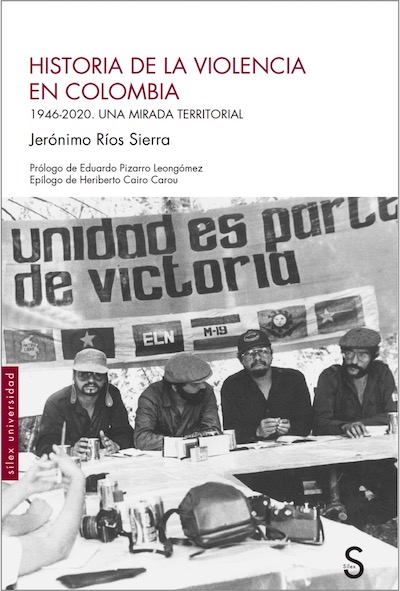Colombia has often complained that its armed conflict perpetually dominates the country's international image. The 2016 agreement that led to the demobilisation of the FARC should give way to other conversations about Colombia than the one that revolves around violence. However, before closing this historical chapter, if it is definitively closed, it is worth taking a detailed inventory of what has happened throughout these decades of leadenness.
Jerónimo Ríos has long been researching this and other episodes of guerrilla warfare in Latin America and has taught about them at various universities on both sides of the Atlantic, now at the Complutense University of Madrid. In Historia de la violencia en Colombia, 1946-2020, Ríos has undertaken this documentary work: he analyzes the origin and evolution of the armed conflict, the responses given by the State, the territorial dynamics of the FARC, the ELN and the paramilitaries, and finally addresses the agreement peace reached in 2016. The implementation of the peace process is dealt with by Ríos in a 160-page sequel, published just a few months apart: Colombia (2016-2021): from territorial peace to unresolved violence. If in this second Issue there are more clues about the future -its degree scroll already indicates the conviction that this is open-, the long previous study by Ríos undoubtedly provides elements for the understanding of the phenomenon.
The author starts from the "Colombian paradox" that, being one of the Latin American nations with the longest tradition of elected governments (it has only had seven years of military governments in its history), it has suffered one of the longest armed conflicts. In fact, before the triumph of the Cuban revolution, there had only been one experience of Marxist-inspired guerrilla warfare in the region, and that was in Colombia during the period of La Violencia in the mid-20th century. Political violence had already appeared in the Thousand Days' War (1899-1902); however, Ríos disagrees with the assertion that Colombia had been doomed to endemic violence since colonial times. He writes that until 1930 "it can be said that the country does not present levels of violence that are exacerbated or out of line with those typical of the region. Rather, what is happening is a gradual collapse of the state, which began to deteriorate after the confrontations that took place between 1930 and 1946 (...) The weakness of a state that was unable to provide itself with sufficient means to exercise its authority over a large part of its territory".
Ríos speaks of two guerrilla cycles in the country: the one that emerged after the revolutionary triumph in Havana in 1959, with the creation of the FARC, the ELN and the EPL, and the one that spurred the Nicaraguan revolution in 1979, with the emergence of the M19, the MAQL and the PRT. The different acronyms sought to integrate into the Simón Bolívar Guerrilla Coordinating Committee, but they did not overcome a fragmentation that prevented them from acting as a unit, as the FMLN did in El Salvador and the UNRG did in Guatemala, and which allowed them to negotiate peace in those two countries.
Peace was slow to be tackled in earnest, perhaps for two reasons, according to Ríos' arguments. One is this lack of guerrilla unity, and the other is drugs: in the late 1990s, the FARC began to finance itself through the coca business, which would lead to an annual income of more than a billion dollars. This allowed them to acquire weaponry that confused them about their true strength. deadline At that time, the FARC believed it was possible to gain power by force, and even the CIA, as Ríos notes, began to "conceive as plausible a possible guerrilla victory over the army in a maximum of five years", if the attacks and the precariousness of the security forces were maintained. But the state ended up reinforcing itself with Plan Colombia agreed with Washington, which finally led the FARC to understand that their only way out was to negotiate their demobilisation....
Of the paramilitary demobilization process, in the framework of the 2005 agreement with the United Self-Defense Forces of Colombia, Ríos notes that only 10% of those who laid down their arms returned to criminality, so he does not seem to consider the Issue of the current FARC dissidents to be excessive. He thinks that the State has also given the opportunity for these groups to continue to have a margin, since point 3 of the 2016 agreement , which foresaw that the Armed Forces and the Police would recover the territory left by the FARC, has been "partially unfulfilled": in Colombia, he concludes, "there is less sovereignty than territory". As for the ELN, the only historical guerrilla in Colombia still in arms, the author believes that for now neither the Government nor that organization is in a position to negotiate peace.
B Jerónimo Ríos' work, profuse with maps detailing the deployment of the different armed groups in the territory over time, is an effort of documentation, elaborated with the help of financial aid of some thirty in-depth interviews with protagonists of the conflict. It is written with the objectivity of someone who, in any case, values democratic coexistence and institutionality.

